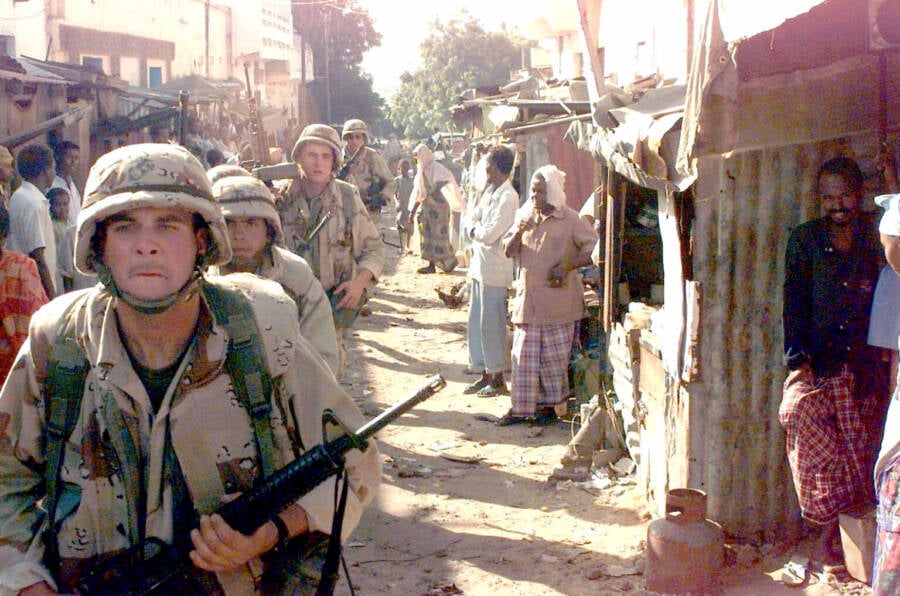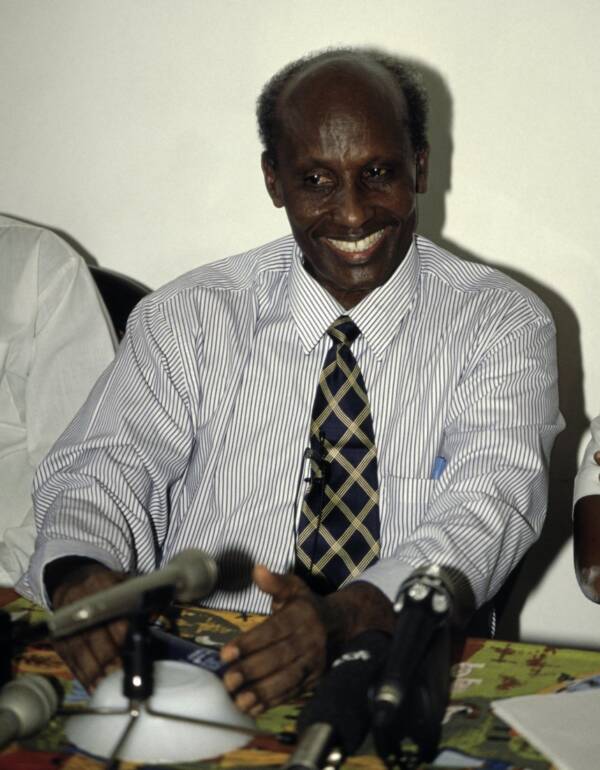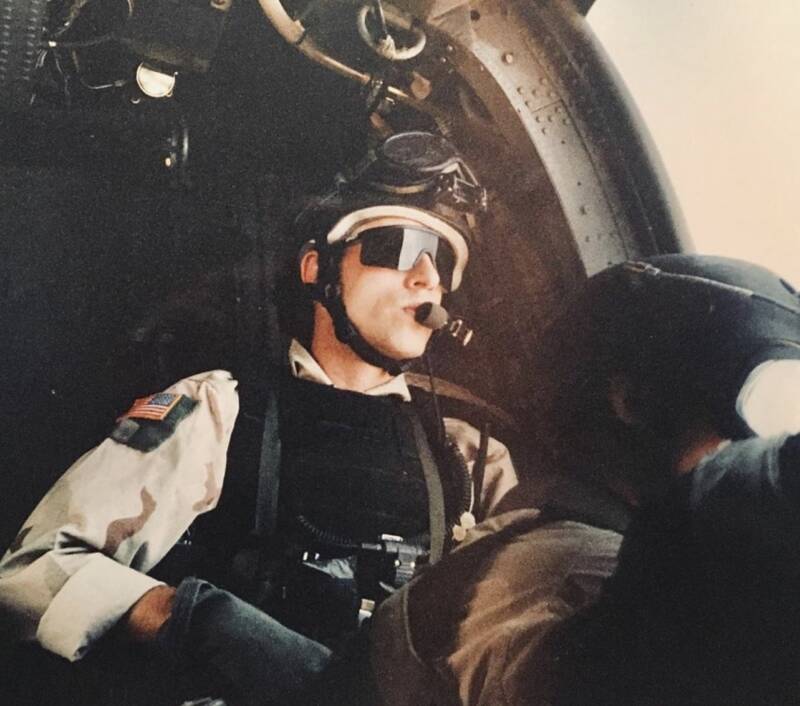On October 3, 1993, U.S. troops clashed with Somali militants in Mogadishu, resulting in two helicopter crashes that inspired the film Black Hawk Down.

National ArchivesU.S. Marines walk through an alley in Somalia’s Bakaara Market in search of munitions as part of Operation Restore Hope.
In October 1993, United States forces became embroiled in an armed conflict against troops loyal to Somali warlord Mohamed Farrah Aidid. Known as the Battle of Mogadishu, the incident is perhaps best remembered for the debacle that later became immortalized in the film Black Hawk Down.
During the battle, Somali militants shot down two Black Hawk helicopters with rocket-propelled grenades, killing some — but not all — of the crew members. Those left behind at the crash sites quickly found themselves surrounded by Somali militiamen, and soon, a rescue operation was underway.
Of the 200 U.S. soldiers involved in the assault, 18 died, and at least 73 others suffered injuries. The mission was a major fiasco, ultimately bringing an end to America’s peacekeeping campaign in Somalia, as President Bill Clinton withdrew U.S. troops shortly after the incident.
This is the true story of Black Hawk Down and the Battle of Mogadishu.
The Somali Civil War And Operation Gothic Serpent
In 1991, the African nation of Somalia was plunged into civil war. As violence raged, peacekeepers with the United Nations traveled to the country to help distribute food and other supplies to famine-ravaged civilians.

Wikimedia CommonsU.S. Marines deliver aid to the people of Somalia.
In December 1992, the U.S. launched Operation Restore Hope to assist with supply distribution and protect the peacekeepers, according to the U.S. Army Center of Military History.
However, the U.S. also began intervening to restore Somalia’s government. As a result, a local warlord named Mohamed Farrah Aidid became increasingly violent toward the U.N. and U.S. presence in the country.
In June 1993, Somali militants attacked U.N. peacekeepers who were inspecting Aidid’s arms depots. Violence continued to escalate, and by August, Aidid was targeting American personnel. In response, U.S. forces set out to capture the warlord.

Wikimedia CommonsA group of Somali militants in Mogadishu.
President Bill Clinton formed a group called Task Force Ranger to carry out the operation. It consisted of 400 Army Rangers, Delta Force operators, Navy SEALs, and Air Force Pararescuemen, among other elite special forces. Their mission was to take down Aidid by any means possible.
Operation Gothic Serpent was underway.
Inside The Battle Of Mogadishu
On Oct. 3, 1993, as part of Operation Gothic Serpent, U.S. troops set out to capture two of Aidid’s top lieutenants in Mogadishu. Led by General William F. Garrison, the mission was supposed to be quick and relatively simple.
As reported by NPR, journalist Mark Bowden noted, “They estimated it would take 30 minutes to 45 minutes to conduct the raid, but things did not go well.”
At first, the operation went smoothly. Troops arrested the lieutenants and 20 other Somalis and prepared to evacuate, but they couldn’t leave as quickly as they’d planned.

Johnny Saunderson/Alamy Stock PhotoGeneral Mohamed Farrah Aidid during a press conference on Oct. 27, 1993.
Army Ranger Shawn Nelson, an M60 gunner on one of the helicopters hovering above the scene, told Bowden that Somali fighters in the streets started shooting at the aircraft just moments into the operation.
“We immediately started taking fire from the ground,” he said. “I could see people below us with weapons maneuvering about.”
Around 40 minutes into the mission, things took a turn for the worse. Somali militants shot down a Black Hawk helicopter with a rocket-propelled grenade.
Then, they took down a second one.
The Rush To Protect The Fallen Black Hawk Helicopters
After the helicopters careened to the ground, U.S. troops raced to the crash sites to rescue the surviving crew members. According to the NCO Journal, around 90 Army Rangers fought their way to the scene of the first crash, where they immediately faced heavy gunfire. They had to take shelter in nearby houses until backup arrived.
One of the men at the scene was 24-year-old Specialist Phil Lepre. He later recalled, “I said a little prayer, took off my helmet, looked at my daughter’s picture, I said, ‘Babe, I hope you have a wonderful life.'”

X (Twitter)Sergeant First Class Randy Shughart, who was killed in action on Oct. 3, 1993, during the Battle of Mogadishu.
Just two soldiers made it to the second crash scene: Master Sergeant Gary Gordon and Sergeant First Class Randy Shughart. The men were able to hold off Somali militants for around 10 minutes before Gordon was fatally shot.
Shughart continued fighting for another 10 minutes before he was killed as well. The Somalis then overran the site, capturing helicopter pilot Mike Durant and holding him prisoner for 11 days.
The following morning, a U.S. and U.N. relief force of roughly 100 vehicles fought its way through Mogadishu to extract the remaining survivors. The 30-minute mission had turned into an 18-hour battle — one that would have long-lasting repercussions.
The Aftermath Of The Battle Of Mogadishu
Once the smoke had cleared, Somali fighters paraded the bodies of dead Americans through the streets. The gruesome scene was plastered on television screens internationally, leading to massive public outcry.
It’s unknown exactly how many Somalis died as a result of the battle. Most estimates fall between 200 and 1,500, but according to BlackPast, the number could be as high as 4,000. Additionally, the Red Cross estimated that roughly 200 Somali civilians were killed in the struggle.
Of around 200 American soldiers involved in the Battle of Mogadishu, 18 died, and at least 73 others were wounded. It was the highest U.S. casualty toll since the Vietnam War.
As Bowden noted while reporting on the aftermath of the Battle of Mogadishu, “We had a gotten to a point… where we kind of thought that we could intervene militarily without getting hurt, without our soldiers getting killed. The incident that I call Black Hawk Down certainly disabused us of that.”

Wikimedia CommonsThe Mogadishu skyline at the time of Operation Gothic Serpent.
President Bill Clinton responded by ordering U.S. troops to withdraw from Somalia. For nearly a decade, the U.S. was hesitant to deploy ground forces anywhere else in the world. Situations America would typically involve itself in, such as the slaughter of hundreds of thousands of Rwandan Tutsis by their Hutu countrymen in 1994, were avoided entirely despite global outcry.
Once again, in 1995, when Bosnian Serbs launched a genocidal campaign against Muslim and Croatian civilians, the U.S. sat idly by, returning to its pre-World War II isolationist philosophy.
This changed after the terrorist attacks of Sept. 11, 2001, which prompted then-president George W. Bush to deploy troops in Iraq and Afghanistan.
Still, the United States largely avoided the Islamic insurgents in Somalia.
The Battle of Mogadishu was later immortalized in the Ridley Scott film Black Hawk Down, which portrayed the harrowing battle — showing the true horrors the troops had faced behind enemy lines.
After learning about the Battle of Mogadishu and the true story behind Black Hawk Down, see our list of the 33 best war movies of all time. Or, learn about how many people truly died during the American Civil War.





